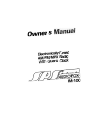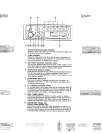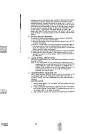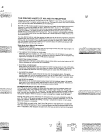
,.
,dit
~
::~~~
I:t;!f;c~r,r"",~Jii""";i"'
:fic:.;.~'fij"~~i.f:':
i~ll.1
~ii~iJ
~
THE DRIVING HABITS OF AM AND FM RECEPTION
Although you may be familiar with both AM and FM reception In your home, you Will experience
notable differences In reception while drIving your car This page will explain why these variances
occur and how they affect the broadcast you are Ilst~nlng to
Both AM and FM provide excellent listening enJoyment and supply the diversified entertainment
necessary to relieve the boredom of hours "behind the wheel" of your car FM receptIon
although uniQue In ItS characteristics whIle driving, provides a totally new sound experience
unlike AM reception The clarity of tone, the richness of sound and the varied program content
provide hours of uninterrupted listening enjoyment The few reception InCOnveniences common
to FM are compensated by the many plus features of a sound experience rivaled only by a live
sound performance
Your new AM.FM radio or radlo,tape system has been buIlt to the strictest engIneering standards
available today and through Quality components and construction will provide maximum perfor-
mance under all conditions A few minutes reading this page will enable you to obtain the most
from FM reception and provide answers to your QuestIons about the differences between AM
and FM operation while driving In your car
Some facts about AM and FM reception:
1 RECEPTION IN TUNNELS
Although you will lose AM re~eptlon when driving through tunnels and under large bridges It IS
common to continue to receive FM reception
2 THE AMOUNT OF STATIONS IN YOUR AREA
Depending upon your location. you Will usually find the amount 01 AM stations In your area
outnumber the amount of FM stations. although the continuing popularity of FM reception hqs
significantly Increased the amount of FM stations nationwide
3 RECEPTION DURING STORMS
Local electrical thunderstorm activity otten produces sharp static sound when listening to AM
stations although you will find that FM IS unaffected
4 ELECTRICAL INTERFERENCE
When listening to AM stations you may experience some buzzing sounds or static when pass.
ing electrical roadside power lines which does not Interfere with FM reception Conversely, FM
may be affected by electrical noise from passing cars or trucks while AM reception is not
5 FM RECEPTION RANGE
FM reception range is usually limited to 50 miles from the broadcast station FM signals
radiate straight out from the broadcast antenna They do not follow earth's curve and are not
reflected back to earth by the atmosphere resulting in lImited "line of sight'. reception range
6 AM RECEPTION RANGE
AM stations can be received several hundred miles from the broadcast station AM sIgnals
follow earth's curve and are easily reflected back to earth by the atmosphere Therefore, an
AM signal is easily received far from the broadcast station antenna
FM RECEPTION WHILE YOu ARE DRIVING
Since FM signals become weaker the further you drive away from the broadcast station you
will experience flutter, nolsy reception and fading In the poor signal fringe area Through the
;nodern circuitry in this radio, this "Fringe Area" has been greatly reduced for greater reception
area Even with this Improved circuitry. eventually the FM signal will become too weak to pro.
VIde Quality reception When this occurs It IS best to change to a stronger. local FM station
Although FM signals are not reflected by the atmosphere they are easily reflected by solid ob.
jects This effect of FM signals pr:>vldes two totally different reception pOssibIlities First, an FM
sIgnal can "bounce" between tall buildings, resulting In unexpected reception In many areas
where AM reception is Impossible
The same effect can result In the "loss" of an FM signal If a large obstruction IS located bet-
ween you and the FM antenna II hills or buildings between you and the antenna block the SIg-
nals, It IS possible to fInd reception very poor even when you are not far from the FM antenna
~IJ
t~i1
~~'~t£
~1~~~
~
':;~;
':;~
~~~;}x:






